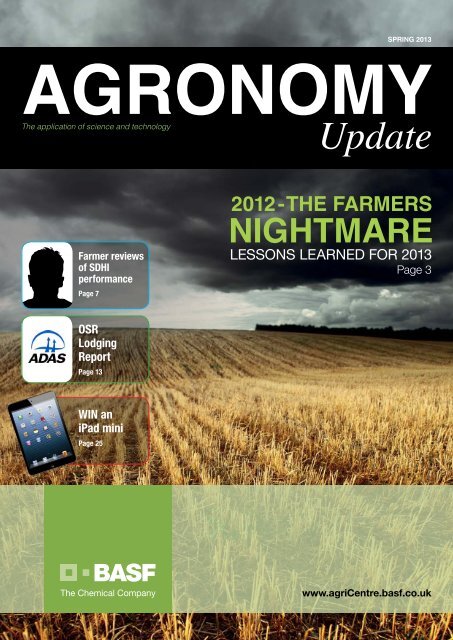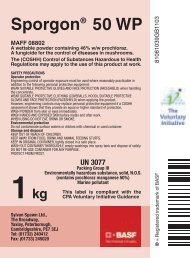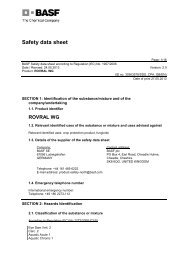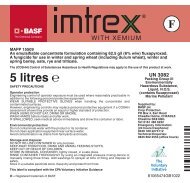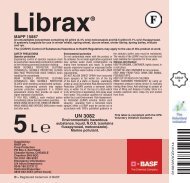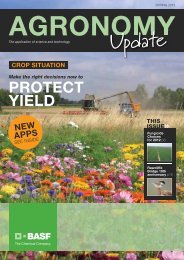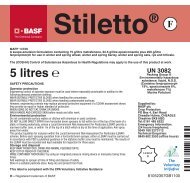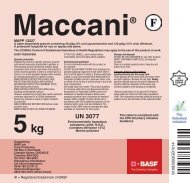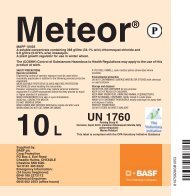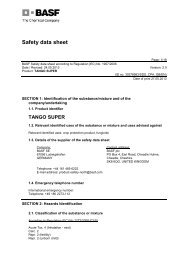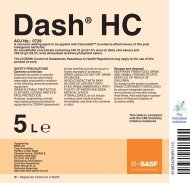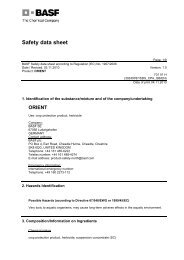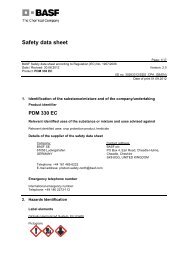Agronomy Update Spring 2013 - agriCentre UK - BASF
Agronomy Update Spring 2013 - agriCentre UK - BASF
Agronomy Update Spring 2013 - agriCentre UK - BASF
- No tags were found...
Create successful ePaper yourself
Turn your PDF publications into a flip-book with our unique Google optimized e-Paper software.
SPRING <strong>2013</strong><br />
AGRONOMY<br />
The application of science and technology<br />
<strong>Update</strong><br />
Farmer reviews<br />
of SDHI<br />
performance<br />
Page 7<br />
2012 - THE FARMERS<br />
NIGHTMARE<br />
LESSONS LEARNED FOR <strong>2013</strong><br />
Page 3<br />
OSR<br />
Lodging<br />
Report<br />
Page 13<br />
WIN an<br />
iPad mini<br />
Page 25<br />
www.<strong>agriCentre</strong>.basf.co.uk
AGRONOMY<br />
The application of science and technology<br />
<strong>Update</strong><br />
Welcome,<br />
My hope for the spring of <strong>2013</strong> is that the sun will shine at the right times to<br />
lift the anxieties <strong>UK</strong> growers have following the hardships of last autumn and<br />
the winter months. We certainly need soils to dry significantly to allow early<br />
applications of fertiliser, herbicides and fungicides to be made in good time<br />
to boost crop potential – as well as to allow a window for those who still have<br />
crops to plant.<br />
In this issue we have some of our agronomy team giving their early season<br />
recommendations for your T0 spray programmes, as well as an update on<br />
some of the ongoing EU pesticide reviews and details of <strong>BASF</strong>’s agronomy<br />
Apps and tools.<br />
May I wish you well for the season ahead.<br />
Contents<br />
Cereals............................................................<br />
2012 the farmers nightmare - lessons learned for <strong>2013</strong> 3<br />
Tricky times for T0 this spring 5<br />
One year on...growers' views on Adexar 7<br />
Mixed bag of crops will make PGRs essential this spring 9<br />
<strong>Agronomy</strong> tools for cereals 11<br />
Oilseed Rape....................................................<br />
Oilseed rape lodging could be affecting 35% of <strong>UK</strong> crops 13<br />
Alternative <strong>Spring</strong> Cropping...............................<br />
New opportunities in maize 15<br />
Pulse area set to increase in <strong>2013</strong> 17<br />
Alternative spring cropping linseed 19<br />
<strong>BASF</strong> News:.....................................................<br />
More scientific approach required to avoid food crisis 21<br />
A future without Triazoles 23<br />
Competition:....................................................<br />
Win an iPad mini 25<br />
YOUR SAY<br />
In the last issue, we asked you for your views on<br />
the magazine. A big thank you to all who sent<br />
their feedback, it’s extremely valuable for us to<br />
ensure we provide the information you want.<br />
We hope you find some positive changes to this<br />
issue, but we would still like to hear your views.<br />
Email: agricentre@basf.com<br />
There is also a chance<br />
to win an iPad mini by<br />
simply completing the<br />
questionnaire on p25<br />
Good luck!<br />
WIN an iPad mini! Page 25<br />
2
Cereals<br />
2012 THE FARMERS NIGHTMARE<br />
LESSONS TO BE LEARNED<br />
FOR <strong>2013</strong><br />
"In many situations there was too<br />
long a gap between T1 and T2"<br />
Dose Rates And Timings<br />
“The incessant rain meant we had very few spray days and it<br />
was almost impossible to get spray timings correct. In many<br />
situations there was too long a gap between T1 and T2,<br />
this meant that the top of leaf 2 was already infected with<br />
Septoria before the flag leaf spray went on, and what we really<br />
needed was a pre flag-leaf spray.” “In addition, poor radiation<br />
levels and cool conditions made leaf emergence slow, making<br />
spray timings even more difficult to get right.”<br />
"If 2012 taught us anything it is that<br />
for the coming season keeping dose<br />
rates of fungicides high will<br />
be critical..."<br />
“The SDHI’s provided essential additional eradicant activity to the<br />
Triazoles and acted to their optimum when applied at the right<br />
timings and dose rates. In fact, if 2012 taught us anything it is<br />
that for the coming season keeping dose rates of fungicides high<br />
will be critical; stripping back dose rates does not save money in<br />
the long run but costs in terms of yield. SDHI chemistry remains<br />
a key cornerstone for any effective fungicide programme; this<br />
chemistry out performs that of stand-alone Triazoles in both a<br />
protectant and eradicant capacity.”<br />
Waterlogging<br />
One interesting facet of the season was that in many areas lighter<br />
soils yielded better than expected and one of the reasons for<br />
this may well be down to the effects that waterlogging has on the<br />
plant – which we are only just starting to fully understand.<br />
Recent studies from China have shown that when soils are<br />
saturated photosynthesis is affected, but also that the movement<br />
of stem carbohydrate into the grain is reduced – affecting the<br />
final yield.This is something that we will be looking into in more<br />
detail in <strong>UK</strong> studies.”<br />
Bill Clarke, of NIAB TAG<br />
“If you look at the recommended list trials and compare the<br />
2012 data with the last 5-year mean treated against untreated,<br />
it is clear that there has been a 17% decrease in yields in 2012<br />
compared with the five -year mean – showing that disease is not<br />
the main reason for a drop in yield – there are more significant<br />
factors at play and this is something that we are looking very<br />
closely into.”<br />
HGCA Fungicide performance<br />
At a recent <strong>BASF</strong> briefing, the latest data<br />
and thoughts on how a range of factors<br />
had an impact on the variable performance<br />
of wheat crops last season as well as<br />
explaining significant local variations in crop<br />
performance, was presented.<br />
Bill Clark of NIAB TAG, tackled the <strong>UK</strong> situation highlighting the<br />
significance and impact of the high levels of summer rainfall,<br />
combined with dull conditions across the country: “The gloomy<br />
conditions of the summer reflected a reduction in radiation levels,<br />
which were down by almost 20% to that of a normal June and<br />
July. This meant grain fill started later and was shorter than in an<br />
average year – so yield potential was already affected before the<br />
impact of severe disease pressure.“<br />
"Suddenly Septoria became a major<br />
issue..."<br />
Disease Profile<br />
“We had started the season being warned of drought conditions<br />
and the disease focus was on early season control of yellow<br />
rust using low dose rates of Triazoles. The rain then arrived and<br />
turned the disease threat on its head; suddenly Septoria became<br />
a major issue, therefore in hindsight T1 sprays should have had<br />
more of a Septoria focus, with more robust dose rates.”<br />
“The late season development of Fusarium was unprecedented;<br />
none of the samples we tested had less than 30% infection - a<br />
result purely of the season and also the difficulty in getting the<br />
chemistry on at the right time.”<br />
Opus<br />
Mean SDHI<br />
Yield t/ha<br />
Dose (proportion of label rate)<br />
Opus<br />
Mean SDHI<br />
Yield t/ha<br />
HGC<br />
3<br />
4
Cereals<br />
Tricky times for T0<br />
THIS SPRING<br />
However as well as managing the crop canopy at this early stage it is<br />
also essential to lay the foundation for disease control and consider<br />
T0 fungicide applications<br />
In backward crops, using nutrients and PGR’s to both even up<br />
and maintain tiller numbers and to promote rooting is the key to<br />
managing for yield, but it is equally important to ensure this work isn’t<br />
compromised by disease. Backward crops are more likely to suffer<br />
increased damage from early disease infections and with poor root<br />
systems they will often suffer from nutrient deficiency early in the<br />
season, reducing the chances of recovery. This will weaken tillers<br />
and perhaps, with high infections, lead to tiller death, just what we<br />
need to avoid. Properly managed fungicide programmes will ensure<br />
the crop is given the best start and protect the potential.<br />
"Early management of mildew, Septoria<br />
and rusts with T0 fungicides..."<br />
T0 fungicides, properly targeted to the risk in field, help to ensure<br />
crops can maintain or increase potential. Early management of<br />
mildew, Septoria and rusts with T0 fungicides will ensure plants<br />
are able to exploit the nutrient and PGR inputs and produce a<br />
clean, healthy, vigorous crop going into spring with maximum tiller<br />
numbers. They also effectively provide some breathing space at T1<br />
by reducing disease pressure at that timing, essential if the weather<br />
remains unsettled. A good multisite fungicide such as Chlorothalonil<br />
combined with an Epoxiconazole based product such as Ignite,<br />
Capalo or Mantra would provide a sound start to the season.<br />
"<strong>BASF</strong> recommend the addition<br />
of Chlorothalonil as an effective<br />
resistance management tool"<br />
T1 fungicides applied to final leaf 3 remain a key input, setting up<br />
the crop for the season and driving yield potential. However, it is<br />
important to know which leaf is emerging at GS 31 and GS 32.<br />
It is possible for backward crops to grow through growth stages so<br />
rapidly that a leaf may be missed. What is assumed to be final leaf<br />
3 may in fact be final leaf 2. Examine main tillers carefully to assess<br />
leaf numbers remaining. If this is the case, the T0 fungicide will have<br />
been essential to maintain green area on leaf 3. T1 disease targets<br />
will be foliar diseases such as rust and Septoria, but stem based<br />
disease can be a yield robber if not controlled also. Using Tracker,<br />
based on the SDHI chemistry of boscalid ensures both leaf and<br />
stem are managed effectively.<br />
T2 fungicide inputs should not be compromised. The flag leaf is the<br />
main driver for yield so the T2 fungicide maintains plant health and<br />
green leaf area through the main yield building period and ensures<br />
that yield potential is maximised. Use the best chemistry available to<br />
exploit that potential and Adexar has demonstrated time and again<br />
its position as the number one technical performance at T2, use at<br />
dose rates of 1.25 to 1.5 l/ha, <strong>BASF</strong> recommend the addition of<br />
Chlorothalonil as an effective resistance management tool.<br />
John Miles of KWS <strong>UK</strong> see’s this seasons fungicide programmes<br />
as being similar to last. “Last year it was all to play for’ he says<br />
‘this year it’s all to protect. Mildew and Septoria can easily be found<br />
already, so the risk is there. Keep an open mind and be prepared<br />
to maintain fungicide input’. KWS trials on KWS Santiago have<br />
also demonstrated the value of PGR applications on tiller and final<br />
ear numbers, with higher rates of PGR increasing ear numbers by<br />
over 30% in some circumstances. “Good disease control and tiller<br />
retention are the key in <strong>2013</strong>,” he added.<br />
<strong>BASF</strong>’s agronomy managers Simon Francis and Dudley Kitching consider the importance<br />
of plant growth regulation and disease management in small crops<br />
Winter Wheat<br />
After the deluge of 2012, many crops of<br />
winter wheat have had to contend with late<br />
drilling into less than ideal seedbeds, slugs<br />
and waterlogged soils. The challenge for the<br />
spring is to ensure that rooting and tillering<br />
can be optimised as soils warm, to maximise<br />
ear numbers and yield potential. Whilst plant<br />
growth regulators are seen as an insurance<br />
Dudley Kitching against lodging, making the right choice of<br />
product for early applications can also enhance rooting and assist<br />
in maintaining viable tillers through to harvest. Meteor, for winter<br />
wheat, and Canopy, for winter wheat and barley both show these<br />
characteristics.<br />
Tillering is the most important process driving canopy formation and<br />
its optimal size for maximising yield potential. A high yielding winter<br />
wheat crop should be managed to achieve at least 400 to 500 viable<br />
shoots (ears)/m 2 by harvest. In barley, yield is even more strongly<br />
dependent on ears/m 2 rather than grain size, and the aim should be<br />
to achieve as many viable ears/m 2 as possible.<br />
The ideal place to start crop assessments is at early tillering using the<br />
Canopy Assessment Tool (CAT) to assess the Green Area Index (GAI)<br />
of the crop and determine shoot numbers coming out of winter.<br />
The CAT has been updated this season to give a measure of shoots/<br />
m 2 in winter wheat from a digital photograph. Where tiller numbers<br />
are low it is important to protect yield by minimising tiller loss to<br />
disease. If shoots/m 2 are significantly less than 1000/m 2 at pre GS<br />
30, it is important to manage them with early nitrogen and from the<br />
use of the PGRs proven to enhance tillering.<br />
An early application of nitrogen to a backward<br />
crop will promote tillering and reduce tiller<br />
death, but the root system must be able to<br />
absorb and utilise this nutrient. A split dose<br />
application of Meteor or Canopy at mid tiller<br />
will reduce the apical dominance of the main<br />
stem and has been shown to improve root<br />
dry matter by up to 27% enhancing nutrient<br />
Simon Francis and water uptake. It also allows nutrients to<br />
be diverted to side tillers thus increasing the number that survive to<br />
produce viable ears at harvest. An additional benefit of this increase<br />
in root depth and diameter is better anchorage of the plant reducing<br />
the danger of root lodging. Meteor and Canopy are effective from low<br />
temperatures above 5°C so can be applied with confidence when<br />
the crops start spring growth and, due to their unique formulations,<br />
provide consistent and gentle manipulation of crop growth.<br />
T0<br />
GS 25-30<br />
T1<br />
GS 30-32<br />
T2<br />
GS 32-39<br />
T0<br />
(But not before<br />
March)<br />
T1<br />
GS 30-32<br />
T2<br />
GS 32-39<br />
Meteor 2.5 L/ha<br />
Winter Wheat<br />
Canopy* 0.3 L/ha<br />
Canopy* + 3C Chlormequat 720<br />
0.6 - 0.8 L/ha + 1.2 L/ha<br />
Terpal 1.0 L/ha + non-ionic wetter<br />
Terpal 1.0 L/ha + non-ionic wetter<br />
OR<br />
Canopy* 0.6-0.8 L/ha<br />
OR<br />
Canopy* 0.6-0.8 L/ha<br />
Meteor 1.75 L/ha<br />
Meteor 0.75 L/ha<br />
Winter Barley<br />
Canopy* 0.3 L/ha<br />
Canopy*<br />
Medium Risk**: 0.4 - 0.75 L/ha<br />
High Risk***: 0.6 - 1.0 L/ha<br />
Terpal 0.7 - 1.0 L/ha + non-ionic<br />
wetter<br />
* Water conditioner to be used in hard<br />
water areas e.g X-Change<br />
**Medium Risk: Medium yield potential,<br />
lighter soils or dry conditions<br />
***High Risk: High yield potential,<br />
heavy soils or good growing conditions<br />
5<br />
6
Cereals<br />
The latest independent trials from HGCA, again confirm Adexar as<br />
the strongest cereal fungicide to control Septoria and yellow rust<br />
Higher yield<br />
Lower yield<br />
Adexar contains the new SDHI Xemium<br />
and the most effective wheat triazole<br />
epoxiconazole<br />
Why should you use it<br />
• Consistently delivers highest yield responses across<br />
multiple seasons demonstrating proven reliability<br />
‘I got an extra 0.74t/ha in<br />
yield by using Adexar compared<br />
to the other SDHI fungicides’<br />
Keith Challen,<br />
Farmer, Lincolnshire<br />
‘If I hadn’t sprayed Adexar,<br />
my yields would have<br />
been lower’<br />
Roger Moore<br />
Farmer, Norfolk<br />
• Highest yield responses of any fungicide<br />
in independent Septoria HGCA trials over three years<br />
• Highest yield responses of any fungicide in independent<br />
yellow rust HGCA trials over two years<br />
• Adexar will deliver the highest return and margin of any<br />
fungicide in a Septoria and yellow rust risk situation<br />
• The independent HGCA trials over the last three<br />
seasons show a half dose rate of Adexar delivers<br />
at least 0.5t/ha more than a full dose rate of Proline<br />
or Ignite, which is worth more than £90/ha*<br />
in additional profit<br />
• Flexible dose rate allows tailored approach delivering<br />
maximum return on investment for a specific situation<br />
depending on yield potential and disease pressure<br />
• High protectant and curative Septoria activity minimises<br />
yield losses if forced to spray early or late<br />
*Assumes wheat price of £180t, assumes likely farm prices for <strong>2013</strong>.<br />
ONE YEAR ON<br />
GROWERS' VIEWS ON ADEXAR<br />
Septoria tritici trial yields<br />
2010-12 (N=18)<br />
Yellow rust trial yields<br />
2011-12<br />
6<br />
6<br />
7.5 7.5<br />
5.5 5.5<br />
"Following use of Adexar, my wheat crops were<br />
visibly greener<br />
It gave more persistent disease control<br />
keeping disease out of the crop for longer<br />
It was a difficult year for yields, but if I hadn’t<br />
sprayed Adexar, my yields would have been lower<br />
Where I didn’t use Adexar, the quality of the crop<br />
was not as good"<br />
Roger Moore, Farmer, Norfolk<br />
"I got an extra 0.74t/ha in yield by using Adexar<br />
compared to the other SDHI fungicides<br />
We were right to use it<br />
These results give me a very good starting point<br />
for making decisions in <strong>2013</strong>"<br />
Keith Challen, Farmer, Lincolnshire<br />
Yield t/ha<br />
7 7<br />
6.5 6.5<br />
Yield t/ha<br />
6 6<br />
5.5 5.5<br />
Seguris Seguris<br />
Proline Proline<br />
Ignite Ignite<br />
Aviator Aviator Xpro Xpro<br />
Yield t/ha<br />
Yield t/ha<br />
5 5<br />
4.5 4.5<br />
4 4<br />
3.5 3.5<br />
Seguris Seguris<br />
Aviator235 Xpro Xpro<br />
Adexar Adexar<br />
Adexar Adexar<br />
5 5<br />
0 0 0.5 0.5 1 1 1.5 1.5 2 2<br />
3 3<br />
0 0<br />
Brutus Brutus<br />
0.5 0.5 1 1 1.5 1.5 2 2<br />
"Wheat leaves and straw were greener after<br />
spraying Adexar<br />
Dose Dose (proportion of full of label full label rate) rate)<br />
Dose Dose (proportion of full of label full label rate) rate)<br />
It gave longer lasting disease control<br />
If I had not used it, yields would not have been<br />
as good<br />
I will be using Adexar again this season"<br />
Richard Raper, Farmer, Thirsk<br />
Go online to watch the full video<br />
of Keith Challen’s harvest<br />
www.adexar.co.uk<br />
Adexar key facts:<br />
• 62.5g/l epoxiconazole + 62.5g/l Xemium<br />
• Wheat, barley, oats, rye and triticale on label<br />
• Mainly for use at T2, but also suited to T1<br />
in higher disease situations<br />
• Fully compatible with chlorothalonil at any<br />
spray timing<br />
• Excellent tank mix compatibility and crop safe<br />
• Available in 10L Ecopacks for easier rinsing<br />
• Available widely through all distributors<br />
7<br />
8
Cereals<br />
Graph 1<br />
The effect of PGR applications on wheat root dry matter<br />
% Root Dry Matter over untreated<br />
Untreated Moddus 0.2 l/ha Moddus 0.4 l/ha Canopy<br />
0.6I/ha<br />
Canopy<br />
1.2 I/ha<br />
Source: <strong>BASF</strong><br />
MIXED BAG OF CROPS WILL MAKE<br />
PGRs ESSENTIAL<br />
THIS SPRING<br />
Wheat planting has been a mixed<br />
bag of establishment success<br />
with many crops having been<br />
late sown into far from ideal soil<br />
conditions. Many agronomists are<br />
suggesting that the right PGRs -<br />
applied at the right time - can help<br />
later and more backward crops<br />
achieve more of their genetic<br />
potential according to <strong>BASF</strong><br />
PGR Product Manager, Sarah<br />
Sarah Mountford-Smith<br />
Mountford-Smith. The challenge<br />
this year will be managing two different crops; those drilled<br />
early or those drilled late which will develop at different timings<br />
and come with their own set of challenges.<br />
Crops that are particularly vulnerable are those which have been<br />
sitting in wet soils or those which were drilled late and have very few<br />
tillers coming out of winter.<br />
“The rooting systems on late drilled wheat crops may be very poor,<br />
especially those that have sat in waterlogged fields for prolonged<br />
periods. Where crops were sown late last autumn, seed rates were<br />
increased almost across the board - however, the hard winter,<br />
not helped by the poor structure of many soils, will have knocked<br />
back crop development and will have left many wheat plants with<br />
less root mass than they need making them potentially vulnerable<br />
to root lodging.”<br />
“Early use of a PGR like Canopy -<br />
to stimulate rooting and protect<br />
against lodging - is going to be<br />
essential this year”<br />
“On such backward crops, boosting root mass to improve both<br />
anchorage strength and support water and nutrient uptake will be key<br />
requirements to maximise yield. Mark Hemmant, Technical Manager<br />
at Agrovista adds that one of the main challenges this spring will<br />
be to encourage wheat plants not to lose any tillers - “we just can’t<br />
afford to,” he says. “This year we are going to have to get everything<br />
agronomically right - whether that’s nitrogen dosing and timings or<br />
fungicide choice and rates. Giving crops every chance you can will be<br />
of paramount importance. As far as PGRs are concerned, early use of<br />
a PGR like Canopy - to stimulate rooting and protect against lodging -<br />
is going to be essential this year.”<br />
Ms Mountford-Smith completely supports Mr. Hemmant’s view<br />
point. Many crops, especially the late sown ones, have significantly<br />
"Achieving the optimum canopy size<br />
is vital to achieve a crop’s maximum<br />
yield potential, and tillering is the<br />
most important process governing<br />
canopy size"<br />
less tillers than is ideal. “Achieving the optimum canopy size is vital<br />
to achieve a crop’s maximum yield potential, and tillering is the most<br />
important process governing canopy size”. Crops with significantly less<br />
than 1000 shoots/m 2 before GS 30 should be managed up with early<br />
nitrogen to increase tiller production and reduce tiller death. “In these<br />
situations, I’m advising an early split PGR application of Canopy at T0<br />
and T1 to promote rooting and enhance tillering; the first dose to be<br />
applied before the end but not before the start of March."<br />
<strong>BASF</strong>’s recommendation is an application of 0.3 l/ha of Canopy at T0,<br />
(with the addition of X-Change in hard water areas) – it is suited to early<br />
use because the product works well at cooler temperatures and over<br />
a wider temperature range than both chlormequat and moddus. At T1<br />
<strong>BASF</strong> recommends a follow up of 1.2 l/ha of 3C Chlormequat 720 +<br />
0.6 l/ha of Canopy.<br />
Based on two complementary active ingredients, mepiquat chloride<br />
and prohexadione-calcium, Canopy is an ideal alternative to a standard<br />
chlormequat programme because both actives stimulate root growth in<br />
young cereal plants. Trials on winter wheat (shown in Graph 1)<br />
Use the CAT App to assess GAI in winter cereals<br />
Assessing a crop’s canopy size can be tricky, but it is an important indicator for<br />
decisions regarding nitrogen and PGR applications.<br />
“Developed, trialled and calibrated by ADAS and <strong>BASF</strong>, the Canopy<br />
Assessment Tool (CAT) provides a quick and easy way of measuring<br />
canopy size by estimating the Green Area Index (GAI) of the crop from a<br />
digital photograph. Measuring GAI allows the amount of nitrogen in the<br />
crop to be determined, as a unit of 1 GAI contains 30 kg N/ha.<br />
Lodging risk can also be estimated from crop GAI when measured<br />
at growth stage 30 or 31 when combined with information on the<br />
varietal standing power and predicted yield of the crop. A suitable PGR<br />
programme will be suggested based on the in-field risk assessment at<br />
the time of taking the photograph. This season the CAT has also been<br />
updated with a new feature to provide a measure of shoots/m 2 from a<br />
digital photograph taken at pre-growth stage (GS) 30, GS 30 and GS 31<br />
for winter wheat.<br />
The CAT is available as a web based tool for use in winter wheat and winter<br />
barley. An App for iPhone is also available, but currently for use in winter wheat<br />
only. To access the tools or to find out more information, please visit our website<br />
at www.agricentre.basf.co.uk.<br />
have demonstrated that applications of Canopy increase root dry<br />
matter by up to 27% over the untreated." Plants treated with Canopy<br />
are rooted more firmly in the ground and have 30% higher tensile<br />
strength. It is certain that this season stimulation and manipulation are<br />
the name of the game to optimise canopy size and protect against crop<br />
lodging yield.<br />
T0 applications of Canopy PGR:<br />
• Stimulates rooting<br />
• Improves root anchorage and protection<br />
against root lodging<br />
• Increases fibrous rooting for improved<br />
uptake of nutrients and water<br />
• Enhances tillering<br />
9<br />
10
Cereals<br />
<strong>BASF</strong> INVEST IN A WIDE RANGE OF PRECISION<br />
AGRONOMY TOOLS<br />
FOR CEREALS<br />
Precision farming is becoming increasingly prevalent and valuable for <strong>UK</strong> farmers.<br />
In response to the growing demand for agronomic support tools, <strong>BASF</strong> has developed<br />
a number of precision <strong>Agronomy</strong> Apps.<br />
The <strong>BASF</strong> Virtual Trials Centre:<br />
Building on the success of the Cereal Herbicide trials, <strong>BASF</strong> has<br />
updated its innovative virtual trials centre online to support decision<br />
making around choice of SDHI fungicides. The virtual trials are an<br />
online tour that offers visual information and data comparing disease<br />
control and yield comparisons in wheat, from a range of fungicides,<br />
including all of the latest SDHI products.<br />
• 2 independent fungicide trials to view<br />
• Compare product performance of SDHI’s – including differences in<br />
time of application<br />
• High quality photos from a range of angles to demonstrate real<br />
results from the field<br />
The updated version is now live and can be accessed at<br />
www.virtualtrials.co.uk.<br />
The <strong>BASF</strong> Weed ID App:<br />
The <strong>BASF</strong> Cereals Disease ID App:<br />
An App version of the popular <strong>BASF</strong> Encyclopedia of Cereal<br />
Diseases. This mobile version of the Encyclopedia, developed in<br />
conjunction with the HGCA and cereal disease expert Bill Clark,<br />
allows users to identify <strong>UK</strong>’s cereal diseases. It is an easy reference<br />
guide to the diseases of <strong>UK</strong> cereals and causal organisms:<br />
• Quick and easy mobile access to<br />
information on 36 key cereal diseases<br />
to aid identification<br />
• Search by pathogen, common name<br />
or free text search<br />
• Includes symptoms, life cycle,<br />
host, importance and photographs<br />
• Email information to email address<br />
of choice<br />
The App is available FREE on Android,<br />
Blackberry and iPhone<br />
The Return on Investment (ROI)<br />
calculator:<br />
The wheat Return On Investment calculator is based on a model<br />
prepared by Andersons Farm Business Consultants.<br />
The calculator is intended to be a guide to review input costs and<br />
margin for producing a crop of wheat.<br />
A yield predictor function of the tool randomly calculates (based<br />
on the yield range for your farm) the estimated yields and margin<br />
you could earn over the next 6 years assuming yields fluctuate<br />
according to the typical range you have entered.<br />
For more information on this tool, visit www.adexar.co.uk<br />
The <strong>BASF</strong> GAI Tool for Winter<br />
Wheat - CAT App for iPhone:<br />
The Canopy Assessment Tool (CAT) provides an accurate and<br />
consistent assessment of crop nitrogen from its green area index<br />
(GAI) and crop lodging risk from a digital photograph. New for this<br />
spring season, the CAT App will also provide a measure of shoots/m 2<br />
at the pre-growth stage (GS) 30,<br />
GS 30 and GS 31 timing supporting<br />
canopy management decisions relating to<br />
the timing and use of nitrogen and PGRs.<br />
The CAT App is available on iPhone for<br />
only £1.99<br />
A web version is available for use free<br />
of charge which can also be used in<br />
winter barley.<br />
The online tool can be accessed at<br />
www.agricentre.basf.co.uk<br />
View individual trial plots or choose up to 3 to compare.<br />
Compare 3 products, view images at different<br />
angles. Overhead, ground level, close up.<br />
Provides an easy to use reference guide to the major broad<br />
leaved weeds and grass weeds in the <strong>UK</strong> aiding identification<br />
of over 140 arable weeds.<br />
• Quick and easy access to extensive weed library of<br />
>1000 images<br />
• Full description of each weed species at cotyledon,<br />
young plant and mature plant growth stages supported<br />
by accompanying pictures aiding identification<br />
• Detailed grass-weed line drawings to highlight<br />
distinguishing features often too difficult to see from<br />
a photograph<br />
• Interactive search of weed library via Weed ID Filter,<br />
Common Name List, Scientific Name List, or Free<br />
Text Search<br />
• Mapmyweed tool to help pinpoint location of weeds on<br />
a Google map; assign name, size of patch and year*<br />
• Option to photograph the weed in your field and use<br />
to directly compare with images in the App library<br />
• Export your weed photo and it’s GPS location by email<br />
to customers / colleagues at the touch of a button<br />
• Simple and fast interface<br />
The Weed ID App is available on iPhone, Android and<br />
Blackberry platforms.<br />
Compare at different angles. Click on photo's to<br />
enlarge and scroll through.<br />
* Mapmyweed not available on Blackberry<br />
11<br />
12
Oilseed Rape<br />
Graph 1<br />
ESTIMATED REDUCTION IN NATIONAL AVERAGE YIELD BASED ON 35% LODGING<br />
OILSEED RAPE LODGING<br />
COULD BE AFFECTING<br />
35% OF <strong>UK</strong> CROP SAYS<br />
The impact of lodging in oilseed rape could be<br />
dramatically underestimated in the <strong>UK</strong> according to a<br />
new report undertaken by ADAS for <strong>BASF</strong>. The report<br />
is based on a comprehensive field survey which found<br />
that, on average, 35% of the crops surveyed were<br />
lodged, but because it occurred in the centre of fields,<br />
on many farms it could go unnoticed until harvest.<br />
“...The financial losses resulting<br />
would have equated to between<br />
£88/ha and £214/ha”<br />
“If the lodged area of 35% were representative of the whole of the<br />
country, it is estimated that it could have reduced the 2012 national<br />
average yield by between 0.25 and 0.61 t/ha*,” explains <strong>BASF</strong>’s<br />
Will Reyer. “The financial losses resulting would have equated to<br />
between £88/ha and £214/ha - a total loss to the industry between<br />
£56 million and £137 million.” ADAS’ report carried out by Dr<br />
Charlotte White and Dr Sarah Clarke identified that lodging losses<br />
result from the collapsed canopy’s reduced ability to intercept light<br />
coupled with difficulties in general crop management and harvest.<br />
“Physically the losses are a consequence of low seed set,<br />
poor seed fill plus pod shatter,” Mr Reyer adds.<br />
A previous review of available published data found that yield losses<br />
depends on when lodging starts and its severity as shown in the<br />
graphs opposite. “Lodging at flowering will reduce seed set and<br />
seed weight whilst if it occurs at early pod fill it is the most damaging<br />
for yield loss - averaging 52% when the crop is 70º to the ground.”<br />
Clare Tucker, <strong>BASF</strong><br />
<strong>BASF</strong> <strong>Agronomy</strong> manager Clare Tucker<br />
advises that assessment of Green Area<br />
Index (GAI) should be routine for all crops<br />
every year if lodging risk is to be reduced<br />
and yield to be maximised.“This tool has<br />
been proven to provide consistent advice<br />
on the effective use of metconazole across<br />
many contrasting years. Growers and<br />
advisors should have absolute confidence<br />
in its ability to gauge the beneficial use of<br />
Sunorg Pro (metconazole) in rape.”<br />
Ms Tucker adds that growers and advisors should ideally use the<br />
GAI tool from March onwards and, if the GAI of the crop is greater<br />
than 0.8, an application of up to 0.8 l/ha of Sunorg Pro to the<br />
crop will be economically justified. “I’d recommend that<br />
applications should be from about mid-stem extension through<br />
to yellow-bud – in layman’s terms - once the crop is visibly growing.<br />
The mid-stem extension application of metconazole in March is the<br />
most effective timing for shorten the crop and reduce lodging risk.<br />
However strong active growth is more important than actual growth<br />
stage so it is better to delay if it is too cold or dry.”<br />
She suggests that the GAI tool should also be used into April at<br />
about yellow-bud. “At this timing Sunorg Pro will maximise canopy<br />
effects and seeds/sq m for yield; it will also reduce lodging risk and<br />
contribute to Sclerotinia control.The April application has been the<br />
most common in recent years, in part due to the need to wait for<br />
sustained active growing conditions before application.”<br />
* Based on an average yield of 3.5 t/ha<br />
Yield loss (t/ha) Yield loss (t/ha)<br />
Yield (t/ha)<br />
3.5<br />
3<br />
2.5<br />
2<br />
1.5<br />
1<br />
0.5<br />
0<br />
Graph 2<br />
0.7<br />
0.6<br />
0.5<br />
0.4<br />
0.3<br />
0.2<br />
0.1<br />
0<br />
Graph 3<br />
300<br />
250<br />
200<br />
150<br />
100<br />
50<br />
0<br />
a<br />
Control<br />
Supported<br />
20<br />
20<br />
b<br />
Late flowing<br />
c<br />
Early pod-fill<br />
Artificial lodging<br />
Yield Yield loss due to lodging (%) (%)<br />
b<br />
Mid pod-fill<br />
Baylis & Wright 1990 (plots lodge to within 20° of the ground)<br />
b<br />
Late pod-fill<br />
ESTIMATED REDUCTION IN NATIONAL AVERAGE YIELD BASED ON 35% LODGING<br />
30 40 50<br />
Baylis & Wright 1990 (plots lodge to within 20° of the ground)<br />
COST OF LODGING BASED ON 35% LODGING AND NATIONAL AVERAGE YIELD OF 3.5T/HA<br />
30 40 50<br />
Yield loss due to lodging (%)<br />
Lodging in OSR – ADAS findings<br />
• Up to 35% of the <strong>UK</strong> crop could be lodged<br />
• The cost on farm could be between £88/ha and £214/ha<br />
• The yield losses are estimated at between 0.25-0.61 l/ha<br />
and 2% loss in oil<br />
• Lodging causes poor light interception, which leads to low<br />
seed set, poor seed fill and pod shattering<br />
The ADAS report also calculated that lodging caused<br />
a 2% loss in oil (ca. £10/t at £350/t) and increased<br />
Glucosinolate levels.<br />
“This year oilseed rape crops are generally smaller<br />
with poor rooting systems and weaker stems so the<br />
risk of lodging could be high because when spring<br />
growth starts, it could be rapid, putting pressure on<br />
the root system.”<br />
The graph shows yield loss estimations for<br />
reductions in yield of between 20% and 50%<br />
in lodged areas.<br />
Loss estimations (£/ha) based on £350/t for<br />
reductions in yield of between 20% and 50%<br />
in lodged areas.<br />
• Lodging leads to reduced pod synchrony, leading to risk<br />
of increased pod shatter<br />
• Lodging at flowering will reduce seed set and seed weight<br />
• Lodging at early pod fill was the most damaging in yield loss<br />
- averaging 52% when artificial lodging to 70º to the ground<br />
13<br />
14
Alternative <strong>Spring</strong> Cropping<br />
NEW OPPORTUNITIES<br />
IN MAIZE<br />
Maize gains favour for biogas production<br />
By Ruth Stanley, <strong>Agronomy</strong> Manager <strong>BASF</strong><br />
According to the latest<br />
information from Waste and<br />
Resources Action Programme<br />
(WRAP) and the National Non-<br />
Food Crop Centre (NNFCC),<br />
there are now 97 non-water<br />
company biogas plants in the<br />
<strong>UK</strong> - 39 of these are classified as<br />
farm feedstock bio digesters.<br />
Ruth Stanley, <strong>BASF</strong><br />
The increase in the number of anaerobic digesters (AD) has created<br />
a market for – and an interest in growing - high biomass crops<br />
such as maize and grass silage. Crops like these are important<br />
for stabilising or supplementing other AD feedstocks such as low<br />
yielding slurries or food waste.<br />
Cereals and rape meal can also be used as AD feedstocks,<br />
giving high biogas yields, but given the current high commodity<br />
prices, they are rarely grown solely for digestion. Because maize<br />
is such a valuable feedstock, it already accounts for 80% of the<br />
material used in biogas production across Europe.<br />
“Early weed control at the cotyledon<br />
stage of the crop is vital because<br />
maize is a poor rooter and early weed<br />
competition causes a problem”<br />
Maize has a natural fit in many rotations as a break crop and can be<br />
used as a tool to control problematic Black-grass. Plant breeders<br />
have made many advances over the last decade to develop a wide<br />
range of varieties to suit early or late harvest situations.<br />
Wing-P is a new herbicide for controlling broad leaved and grass<br />
weeds from <strong>BASF</strong>. Wing-P combines two complimentary active<br />
ingredients (dimethenamid-P and pendimethalin). The product<br />
is best used at the pre-emergence timing but if weed control<br />
is delayed (for example by the inability to spray due to weather<br />
conditions) it can also be used early post-emergence from 1 true<br />
leaf to the 4 leaf stage of the crop.<br />
The dual activity of the two active ingredients in Wing-P increases<br />
the range of weeds that the product is effective on and also<br />
increases the activity of the herbicide against certain weeds<br />
compared to straight pendimethalin products.<br />
In addition to excellent early weed control, Wing-P also provides<br />
residual control of weeds through to the later stages of crop growth.<br />
This ensures that the yield potential is not compromised by later<br />
emerging populations of weeds.<br />
<strong>BASF</strong> Recommendation for Weed Control<br />
In Maize<br />
• Apply 3.2 litres per hectare of Wing-P<br />
pre-emergence of the crop<br />
• Where there is a risk of heavy infestations of weeds<br />
apply 4 litres per hectare of Wing-P<br />
pre-emergence of the crop<br />
For further information on Wing-P including the product<br />
label please visit: www.agricentre.basf.co.uk.<br />
Maize<br />
Forage maize has traditionally been grown in the west of the <strong>UK</strong>,<br />
but with the increasing number of anaerobic digesters coming on stream<br />
there are now opportunities for growers in eastern counties to take<br />
advantage of the opportunities which growing this crop brings.<br />
Long-term contracts to supply maize to anaerobic digesters are on offer.<br />
"Yields for varieties grown for<br />
anaerobic digesters should be 45 to<br />
60 tonnes per hectare and contracts<br />
to supply digesters should be worth<br />
around £35 to £40 per tonne"<br />
In terms of the economics of the crop, yields for varieties grown for<br />
anaerobic digesters, yield should be 45 to 60 tonnes per hectare and<br />
contracts to supply digesters should be worth around £35 to £40<br />
per tonne.<br />
Over the past few years the area of maize in the <strong>UK</strong> has seen a steady<br />
increase. The total area in 2012 was thought to be about 160 kha.<br />
The area increase is expected to continue in <strong>2013</strong> as spring cropping<br />
will be more in demand. However with maize being grown widely across<br />
Europe and plenty of choice in terms of varieties, maize seed availability<br />
in <strong>2013</strong> is also not expected to be a problem.<br />
Varieties<br />
Selecting the correct variety is key and is dependent on the intended<br />
end use of the product. For anaerobic digestion varieties should be<br />
used to ensure maximum yield as the main consideration,<br />
whereas starch content should be the main driver when growing<br />
as a forage crop.<br />
Drilling Considerations<br />
Maize is generally sown mid-April time and harvesting is carried out<br />
towards the end of September or into October. When drilling be<br />
aware of soil temperatures. For light soils the temperature must be<br />
8°c for 3-4 days and for heavier soils 10°c for 3 to 4 days should be<br />
observed. This ensures the best possible establishment of the crop.<br />
Weed Control In Maize<br />
The quality parameters for maize intended for use in anaerobic<br />
digesters are different than those crops intended for use in forage.<br />
For energy maize, high yield is the main driver and hence the<br />
agronomy around the crop has come more into focus. Where crop<br />
mass and preserving yield is important the best approach to weed<br />
control is pre-emergence of the crop. Post-emergence applications of<br />
herbicides can be harsh on maize and ultimately limit yield potential.<br />
For growers considering maize for<br />
the first time, there are key points to<br />
consider. Maize needs:<br />
• Good soil structure<br />
• Soil moisture<br />
• Good establishment<br />
To maximise yields it is essential to<br />
get plants off to a good start.<br />
According to Simon Draper,<br />
Agronomist for the Maize Growers<br />
Association, “early weed control at<br />
the cotyledon stage of the crop is<br />
vital because maize is a poor rooter<br />
and early weed competition causes<br />
a problem” to the emerging seedling.<br />
Timing is critical. Don’t be tempted<br />
to leave your herbicide applications<br />
too late as weed competition can<br />
dramatically knock the crop back.<br />
The best approach therefore is a<br />
reliable pre-emergence herbicide<br />
with good residual activity.<br />
Small Nettle (n=1)<br />
Red Deadnettle (n=1)<br />
Wing-P Shows Increased Activity Against Key Weeds Compared<br />
to Straight Pendimethalin Products<br />
Charlock (n=1)<br />
Chickweed (n=6)<br />
Cleavers (n=1)<br />
Fat Hen (n=4)<br />
Wing-P 3.2 L/ha<br />
Stomp Aqua 3.3 L/ha<br />
Scentless Mayweed<br />
(n=2)<br />
Groundsel<br />
(n=3)<br />
Annual Meadow-grass (n=9)<br />
Redshank (n=3)<br />
Black Nightshade (n=12)<br />
Shepherds Purse (n=1)<br />
Common Field<br />
Speedwell (n=4)<br />
Orache (n=2)<br />
Pale Persicaria (n=1)<br />
<strong>BASF</strong> Trials (numbers in brackets indicate number of trials)<br />
3.2 l/ha Wing-P delivers 800 g/ha pdm + 680 g/ha DMTA-P<br />
Contributor: John Burgess - Maize product manager, KWS<br />
15<br />
16
Alternative <strong>Spring</strong> Cropping<br />
Nirvana is a herbicide which was specifically developed for use in<br />
all pulse crops. The product contains two complementary active<br />
ingredients (pendimethalin and imazamox) and offers broadspectrum<br />
control of weeds through excellent residue activity.<br />
Used at appropriate rates Nirvana is a one-hit solution for weed<br />
control which should help ensure that no post-emergence weed<br />
control is required. Mycosphaerella Ascochyta<br />
Nirvana – Key Points<br />
Active Substances:<br />
Imazamox 16.7 g/litre and Pendimethalin 250 g/litre<br />
Recommended crops:<br />
Combining peas, vining peas<br />
<strong>Spring</strong> and winter field beans<br />
Sector<br />
Broad-spectrum weed control<br />
Timing:<br />
Pre-emergence of the crop<br />
Maximum dose:<br />
4.5 litres/ha. One application per crop<br />
Chocolate spot<br />
Bean rust<br />
Water volume:<br />
200-300 litres/ha<br />
PULSE AREA SET TO<br />
INCREASE IN <strong>2013</strong><br />
<strong>UK</strong> Pulse crops have been in decline for several seasons, 2012 saw a 25 year low<br />
of just 121,000 ha, down from 248,000 ha in 2009 (Source Defra).<br />
With a difficult autumn forcing a focus towards spring-sown crops,<br />
peas and spring beans present an attractive option for many<br />
growers, <strong>2013</strong> will certainly see an increase. The many agronomic<br />
benefits of retaining pulses in rotation include the opportunity<br />
to spread the sowing and harvesting work load, break disease<br />
cycles, tackle black-grass and other weed problems, reduce slug<br />
populations, boost first wheat yields, improve soil conditions,<br />
and residual slow release nitrogen for following crops.<br />
<strong>Spring</strong> Beans<br />
The bean crop enjoys a wider geographical spread than peas<br />
and is a good option for those on slightly heavier soils. Beans will<br />
stand well at harvest, enabling a much more flexible approach<br />
to combining. There are premium prices for beans for human<br />
consumption with a vibrant export market. <strong>UK</strong> beans - the best<br />
quality in the world - are in high demand for the North African and<br />
Middle East market, where they form part of the staple diet.<br />
A good visual sample is essential and the decline in production has<br />
meant that prices remain high. Beans that do not make the human<br />
consumption grade have a ready market for feed and prices tend<br />
to be linked to soya as the alternative source of protein.<br />
<strong>Spring</strong> beans provide benefits in the rotation such as the<br />
opportunity to tackle black-grass problems, graminicides such as<br />
Aramo can be applied to beans post-emergence. In addition to this<br />
benefit there is evidence which shows that wheat following beans<br />
in the rotation can provide additional yield to the wheat crop.<br />
This is due to the ability of beans to fix nitrogen and therefore<br />
ensure more N is available in the soil for following crops.<br />
Peas<br />
Recent years have seen the pea crop become more concentrated<br />
in East Anglia and the south-eastern quarter of the <strong>UK</strong> and in<br />
locations with lighter soils and favourable microclimates where<br />
cropping and harvesting are most reliable. Peas are grown with the<br />
premium human consumption market in mind, which makes them<br />
a very attractive proposition. The <strong>UK</strong> marrow fat pea is a product<br />
in demand. More recent declines in production have meant very<br />
strong prices and committed growers have enjoyed good returns.<br />
The <strong>UK</strong> now has just 500-600 producers of dried peas and new<br />
recruits are vital to the industry.<br />
Weed Control in Peas and Beans<br />
Over a number of years the choice of herbicides to use in legume<br />
crops has diminished. Older products containing active ingredients<br />
such as simazine and trifluralin are no longer available. In addition<br />
the choice of post-emergence weed control is restricted to just<br />
bentazone (as in Basagran SG). For this reason the best approach<br />
for weed control in legume crops is to use a broad-spectrum<br />
pre-emergence option.<br />
Nirvana – Key Points<br />
Combining peas and Field beans - Pre-emergence<br />
One-shot solution in many situations<br />
4.5 l/ha Provides long-lasting broad-spectrum weed control<br />
For moderate to high weed populations<br />
3.0 l/ha For moderate weed populations<br />
General broad-leaf weed control<br />
May require a post-emergence follow-up<br />
2.5 l/ha As a tank-mix partner<br />
Broader spectrum than straight pendimethalin<br />
Beware of compromising Nirvana’s weed control benefits<br />
Vining peas - Pre-emergence<br />
2.5 - 3.5 l/ha Match the dose to the soil type<br />
May require a post-emergence follow-up<br />
Post-emergence weed control in<br />
field beans<br />
Whilst pre-emergence control of weeds is preferable in beans,<br />
there are some situations which may require a post-emergence<br />
application of herbicide. In this situation the only option is using<br />
Basagran SG. Growers should be aware however there are<br />
guidelines around the use of bentazone.<br />
Full details of these guidelines can be found at the Voluntary<br />
Initiative website : www.voluntaryinitiative.org.uk/_<br />
Attachments/Resources/1341_S4.pdf<br />
Disease control in peas and beans<br />
Once pulse crops are established in the field and weed control has<br />
been achieved. Growers should be aware of the threat of disease<br />
to these crops.<br />
Pea growers should be aware of the three main diseases.<br />
These are leaf and pod spot (Mycophaerella and Ascochyta) and<br />
grey mould (Botrytis). These diseases all affect the yield and quality<br />
of pea crops and therefore growers should have in mind a disease<br />
control programme to avoid severe infestations, particularly if<br />
conditions become damp and humid in the summer months.<br />
A sensible approach to disease control in peas would be a 2 spray<br />
programme, with the first spray being applied at early flowering or<br />
first pod. The second spray can then be applied at late flowering<br />
ensuring there is a two week interval between treatments.<br />
Botrytis<br />
In field beans the main diseases to be aware of are chocolate spot<br />
early in the season followed by the later threat of bean rust.<br />
Disease control is normally achieved via a two spray programme.<br />
The first spray should be applied at early flowering and then<br />
followed up approximately 4 weeks later at mid to late pod fill.<br />
<strong>BASF</strong> has a range of solutions to help growers maintain yield and<br />
quality in their pulse crops, by ensuring that diseases are controlled.<br />
The tables below give an overview of the products and their activity<br />
against the key diseases in both peas and beans. Growers should<br />
always read the labels before using these products. Product labels<br />
are available at: www.agricentre.basf.co.uk.<br />
Combining and Vining Peas<br />
Walabi<br />
(combining peas)<br />
Signum<br />
Sunorg Pro<br />
Walabi<br />
Signum<br />
Sunorg Pro<br />
Compass<br />
Botrytis Mycosphaerella Sclerotinia Powdery Mildew Ascochyta<br />
*** **** ( * ) ** ****<br />
***** **** ***** *** ****<br />
** *** **** ** ***<br />
* = poor control, ***** = excellent control<br />
Field Beans<br />
* = poor control, ***** = excellent control<br />
Chocolate Spot Bean Rust Ascochyta<br />
*** ( * ) ***<br />
***** **** ( * ) ****<br />
** ( * ) ***** *<br />
**** **<br />
Contributor: Roger Vickers – PGRO (Chief Executive)<br />
17<br />
18
Alternative <strong>Spring</strong> Cropping<br />
Products with on-label recommendations<br />
for use in linseed:<br />
Aramo – grass weed control in linseed<br />
Susceptible grass weeds include volunteer barley, volunteer wheat,<br />
blackgrass, annual meadow grass and common couch.<br />
Laser – grass weed control in linseed<br />
Laser is another herbicide used to control grass weeds in linseed.<br />
Laser has activity on the following weed species: cultivated and wild<br />
oats, volunteer barley and wheat, blackgrass, canary grass, Italian<br />
ryegrass, loose-silk bent, perennial ryegrass, sterile brome and soft<br />
brome, black bent, onion couch, creeping bent.<br />
Basagran SG – post-emergence broad leaved weed<br />
control in linseed<br />
Basagran SG has control claims against a wide variety of weeds.<br />
Full details of susceptible weeds are listed on the product label which<br />
can be found at: www.agricentre.basf.co.uk<br />
ALTERNATIVE SPRING<br />
CROPPING: LINSEED<br />
The maximum permitted dose of Basagran SG on linseed is listed<br />
on the label, however growers should be aware that a voluntary<br />
stewardship scheme exists for the use of products containing<br />
bentazone (such as Basagran SG). Details of this stewardship<br />
scheme can be found at the following address:<br />
www.voluntaryinitiative.org.uk/_Attachments/Resources/1341_S4.pdf<br />
Products with off-label uses in linseed:<br />
The following products from the <strong>BASF</strong> range can also be used on<br />
linseed. These products have received Extension of Authorisation for<br />
Minor Uses on Linseed (previously referred to as off-label approval).<br />
Herbicides with authorised uses in linseed:<br />
Butisan S is a residual herbicide for control of broadleaved and<br />
some grass weeds.<br />
Fungicides with authorised uses in linseed:<br />
Like other crops, linseed is susceptible to a range of fungal<br />
pathogens including botrytis, alternaria, and mildew species.<br />
Caramba and Sunorg Pro (both containing metconazole) and Filan<br />
(containing boscalid) are fungicides which have known activity<br />
against these diseases.<br />
For further information on the use of all these products consult<br />
the product labels at www.<strong>agriCentre</strong>.basf.co.uk<br />
The area planted to linseed has varied widely<br />
from a low of 2,000 ha to a high of 58,000 ha.<br />
The fluctuation being as much a factor of the<br />
success of winter plantings and crop survival as<br />
the intention to grow a spring crop. This year looks<br />
as if the area planted will be at the higher end of<br />
the scale for fairly obvious weather related reasons.<br />
This increase in demand has meant that one variety has already sold out<br />
and while there will be seed available the varieties may not be well known<br />
as demand sucks in seed from outside the <strong>UK</strong>.<br />
Why should growers consider linseed<br />
this year<br />
The major reasons are that linseed does not share the same pest or<br />
disease complex as other <strong>UK</strong> grown crops, so in that respect can be<br />
considered an ideal break crop. In addition by using the appropriate<br />
herbicide, broad leaf and grass weeds can be well managed.<br />
Harvesting is not the problem it once was with diquat.<br />
Glyphosate applied as the seed is turning from white to light honey<br />
colour will enable combining to take place about 3-4 weeks later.<br />
In many cases glyphosate application can take place at the end of the<br />
first week in August.<br />
Linseed needs to be dried to just below 9% moisture and be cleaned to<br />
achieve 2% or less admixture. In this case the unthrashed seed heads or<br />
bolls count as admixture.<br />
Historically the major producers of linseed have been Canada and China.<br />
Now, however, we are seeing increasing amounts of linseed being<br />
imported from CIS countries in particular from Russia and Kazakhstan<br />
who over the last two years have exported around 450,000t per annum<br />
into the EU. When talking to Linseed Crushers the Russian/Kazakhstan<br />
linseed quality (oil, moisture & admixture) tends to be better than <strong>UK</strong><br />
produce. However, with past worries over GM content from Canadian<br />
supplies, <strong>UK</strong> sourced seed is preferred by human consumption buyers.<br />
Global linseed opening stocks/production for 2012/13 is estimated to be<br />
2.52mil/t with a usage of 2.24mil/t which will leave a balance of 0.28mil/t,<br />
keeping markets ‘tight’.<br />
Contributor: David Whyte, United Oilseeds, Devizes<br />
19<br />
20
<strong>BASF</strong> News<br />
Stephen Henning<br />
Stephen Henning is <strong>BASF</strong>'s Crop Protection Regional<br />
Director for the <strong>UK</strong>, Ireland, the Nordics and Baltics.<br />
He is also Chairman of the Crop Protection Association.<br />
He was born in 1965 in South Georgia in the USA.<br />
He is married with four children and is a graduate with<br />
a BS in Biology from Shorter University. He has spent<br />
most of his career with <strong>BASF</strong> within the agricultural<br />
industry both in the USA and in the <strong>UK</strong>. Stephen has a<br />
keen interest in including American football and baseball.<br />
voice will provide a solid platform for the CPA's new CEO - Nick von<br />
Westenholz, to build further change to aid a regulatory environment<br />
more in tune with productive farming."<br />
"We must get away from this<br />
mindset and re-establish a regulatory<br />
approach driven by science”<br />
Mr Henning describes the current EU policies in regulating plant<br />
science and crop protection innovations as "impeding to or<br />
restrictive of production". "We must get away from this mindset<br />
and re-establish a regulatory approach driven by science.”<br />
An example of the difficulties being faced by the CPA, its umbrella<br />
organisation the European Crop Protection Association (ECPA)<br />
and the global association Crop Life International, is the current<br />
endocrine disruption (ED) review currently being undertaken by<br />
the European Commission. The review targets crop protection<br />
products suspected of having endocrine effects - which could make<br />
important groups of chemistry like the triazoles vulnerable<br />
to de-listing across Europe.<br />
The argument surrounds the establishment of the regulatory<br />
definition of an endocrine disrupter. The current proposal is not<br />
science-based and the industry, in partnership with scientists and<br />
researchers, is strongly arguing that the approach should not be<br />
adopted. If they fail, triazoles could be lost to the review process.<br />
There is a full-length feature on the ED review on page 24.<br />
"<strong>BASF</strong> strength has and remains focussed on creating innovative<br />
solutions for our customers. R&D expenditure across all divisions<br />
of <strong>BASF</strong> is approximately 1.74 billion euros/year. Into agriculture,<br />
<strong>BASF</strong> invests around 10% of global sales revenues into R&D every<br />
year. <strong>BASF</strong> is absolutely committed to finding innovations, not only<br />
to make the farmer's business more successful, but to increase the<br />
amount of safe, quality food produced."<br />
"This is an important message for the<br />
farming industry to hear. We continue<br />
to invest"<br />
"We are making continued investment into discoveries in traditional<br />
chemistry we already use i.e. herbicides, insecticides and<br />
fungicides - this is and will remain a core part of <strong>BASF</strong>'s strategy.<br />
In addition we are expanding our R&D focus outside of traditional<br />
crop protection into other key challenges such as water & nutrient<br />
management & utilisation. This is an important message for the<br />
farming industry to hear. We continue to invest."<br />
“...We are all in this together”<br />
For the future of profitable <strong>UK</strong> farming, the work of organisations like<br />
the CPA, defending farmers’ ability to efficiently produce more,<br />
is one of the fundamental building blocks for the future. "Surely we<br />
are all in this together - to produce more, safe food while protecting<br />
our natural resources."<br />
MORE SCIENTIFIC APPROACH REQUIRED<br />
TO AVOID FOOD CRISIS<br />
Mr Henning says that defence of such valuable technology is<br />
fundamental to increasing productive agriculture. He explained<br />
that to put the productivity need into perspective, OECD/FAO have<br />
stated that we need to increase food production by at least 70% by<br />
2050 - that equates to an extra one billion tonnes of cereals per year<br />
and an extra 200 million tonnes of meat per year. "It is clear that we<br />
cannot continue to ignore the challenges ahead and the fact that<br />
science based regulation is essential in meeting these challenges."<br />
In a bold statement last August, Stephen Henning<br />
- in his role as Chairman of the Crop Protection<br />
Association (CPA) - warned that EU policy<br />
makers must rethink their stance on production<br />
agriculture if they want to avoid a food crisis<br />
with devastating consequences. His warning<br />
was meant to be alarmist because he and fellow<br />
members of the CPA want to see a shift in policy<br />
makers' mindset that moves the EU's regulatory<br />
environment for crop protection products from<br />
one that is hazard-based and emotion-fuelled<br />
into one that is science-based.<br />
"The CPA represents 90% of the <strong>UK</strong><br />
market that manufactures, sells and<br />
advises on crop protection products"<br />
The CPA represents 90% of the <strong>UK</strong> market that manufactures,<br />
sells and advises on crop protection products. The body's remit<br />
- to increase the supply of safe food - is firmly where it should be<br />
as agriculture gears itself towards producing more, from less whilst<br />
being environmentally dependable.<br />
The organisation is important to farmers for two reasons explains<br />
Mr Henning. "The pivotal role it plays is in protecting active<br />
ingredients to allow farmers to continue to produce high-yielding<br />
crops. In addition, the CPA is very involved in supporting farmers to<br />
use and manage crop protection products responsibly - through the<br />
Voluntary Initiative and other activities. The industry's responsible<br />
care in this area is well viewed by policy makers because it shows<br />
that it can be delivered without legislation."<br />
The organisation has become a strong lobbying organisation,<br />
alongside the NFU and AIC - giving it a place at policy negotiating<br />
tables, with NGOs and in the media. "The process of gaining a<br />
credible voice was a clear focus of the association. That credible<br />
Examples like the ED review process highlight that the appetite<br />
for innovation in plant science or crop protection in Brussels -<br />
conventional or novel - is low Mr Henning suggests.<br />
"These technologies offer so many opportunities for Europe's<br />
farmers to deliver sustainable production gains and the R&D into<br />
them needs to be fostered. Yet such advances are discouraged<br />
by a seemingly anti-productive farming policy agenda in Europe."<br />
"Along with pharmaceuticals, crop<br />
protection is the most scrutinised<br />
industry"<br />
"Along with pharmaceuticals, crop protection is the most scrutinised<br />
industry; we have a robust and reliable system. The regulatory<br />
process is incredibly thorough with about 800 requirements<br />
needing to be addressed and more than 200 studies filed for a<br />
registration. This process can span from 8-10 years and cost an<br />
R&D manufacturer like <strong>BASF</strong> 250 million euros before its approved<br />
for sale”<br />
21<br />
22
<strong>BASF</strong> News<br />
A future<br />
WITHOUT TRIAZOLES<br />
European arable production is facing a potential crisis with the risk of losing some of the most<br />
powerful crop protection actives necessary for profitable crop production through the latest<br />
European Commission review.<br />
"This review could result in the loss<br />
of azole chemistry meaning a drop in<br />
cereal and oilseed rape yields"<br />
This review could result in the loss of azole chemistry meaning a<br />
drop in cereal and oilseed rape yields of the same magnitude as<br />
those experienced by many growers in 2012; without a doubt the<br />
life of the <strong>UK</strong> arable farmer would become more difficult as our<br />
efficiency of production and competitiveness on the world market<br />
would be seriously challenged.<br />
The question arises how this decision is being approached by the<br />
European Commission, what role the <strong>UK</strong> industry as a whole is<br />
taking in this process, as well as examining the real implications on<br />
the future production of food for the <strong>UK</strong> and Europe.<br />
This process sits entirely in the hands of the European Commission<br />
(EC) which is currently at the stage of reviewing its strategy<br />
on agrochemicals that may have the potential to be defined<br />
as ‘endocrine disrupters’ (ED.) An endocrine disrupter is ‘an<br />
exogenous substance or mixture that alters the function(s) of the<br />
endocrine system and consequently causes adverse health effects<br />
in an organism, its progeny or (sub) populations.’<br />
In June of 2012, the EC organised a conference on<br />
“Endocrine Disruptors – current challenges in science and policy.”<br />
The outcome of this conference has fed into the review of the<br />
European Commission’s current strategy on endocrine disruptors.<br />
Crucially, it also provided input to the Commission’s upcoming<br />
proposal to identify the criteria for regulating the identification of<br />
substances with endocrine properties.<br />
"We are incredulous that such<br />
legislation can be passed when there<br />
has been so little scientific basis"<br />
Across the industry, independent researchers, chemical<br />
manufacturers and industry bodies such as the ECPA (European<br />
Crop Protection Agency) and CPA (Crop Protection Association) are<br />
working to encourage a scientific basis for the regulatory definition<br />
of an endocrine disrupter, which is currently based on hazard rather<br />
than risk, and also to highlight the socio-economic importance in<br />
European agriculture of azole active substances, as well as other<br />
compounds that could potentially be classified as ED’s.<br />
“We are incredulous that such legislation can be passed when there<br />
has been so little scientific basis to the legislation to date, we have<br />
no idea how far the legislation will go and what we are really facing.<br />
It highlights real deficiencies in the European Parliament,” says Bill<br />
Clark of NIAB TAG.<br />
“We are facing a possible future<br />
without triazoles which would<br />
completely change farming systems<br />
across Europe"<br />
“We are facing a possible future without<br />
triazoles which would completely<br />
change farming systems across Europe.<br />
The argument about replacement and<br />
substitution rarely addresses the range<br />
of crops we currently produce. Triazoles<br />
are used for controlling a massive number<br />
of diseases across many crops and this<br />
Bill Clarke<br />
breadth of activity cannot be replaced by<br />
another fungicide group. Future disease control would involve many<br />
fungicides and many more applications, all of which would lead to<br />
higher input costs and lower yields.”<br />
“There is also a longer term issue with resistance to consider.<br />
Triazoles have been a robust group of products in terms of resistance.<br />
Any substitution groups would almost certainly be short-lived unless<br />
they were used in mixture with the triazoles. A short term fix such as<br />
more widespread use of SDHI fungicides would simply increase the<br />
risk of losing these products too,” he says.<br />
“If we lost the triazoles and relied on substitution then there could<br />
be a cliff-edge effect where the substituted products could lose<br />
efficacy rapidly with disastrous consequences in yield terms.<br />
For example although the SDHI fungicides control Septoria tritici,<br />
the reliance on SDHIs alone against Septoria is considered bad<br />
practice (due to its single site mode of action) and it would likely<br />
result in the rapid development of SDHI resistance in Septoria tritici.”<br />
“We also need to consider that the time scale would be so short<br />
we would not realistically have time to react as an industry, say by<br />
developing more resistant varieties, or new cropping systems.”<br />
John Peck<br />
“If Europe is to remain competitive,<br />
we must invest to protect our harvests.<br />
Research and development is costly<br />
and time consuming, but failure to equip<br />
farmers with the right tools for the job will<br />
have serious implications on productivity”,<br />
said Friedhelm Schmider, Director<br />
General of the European Crop Protection<br />
Association (ECPA).<br />
John Peck, Technical Manager <strong>BASF</strong>, believes that the danger of this<br />
approach is that it does not take into account the risk and focusses<br />
purely on the hazard; with little or no evidence to support the theory<br />
that the loss of triazoles would significantly improve the health of<br />
human beings or the environment: “Fundamentally we do not really<br />
know what we are dealing with and where this is going to take us,<br />
in terms of actual product loss and its effect on <strong>UK</strong> agriculture.”<br />
“This has now become a food security issue,” expands Jonathan<br />
Blake of ADAS. “Back in 2011 ADAS looked at the potential impact<br />
of the loss of azoles on wheat yields alone. This report (written in<br />
collaboration with ARVALIS and Aarhus University) evaluated the<br />
effect of losing all azoles on wheat production in the <strong>UK</strong> and other<br />
European countries.<br />
"The estimated total loss of wheat<br />
production which would be caused<br />
by the loss of azoles would be 6.8%<br />
representing a value of 157 million<br />
euro to the <strong>UK</strong> alone"<br />
“The estimated total loss of wheat production which would be<br />
caused by the loss of azoles would be 6.8% representing a value<br />
of 157 million euro to the <strong>UK</strong> alone. The projected losses were<br />
primarily attributed to the loss of control of Septoria tritici.”<br />
This value was calculated before the introduction of SDHI fungicides<br />
which have subsequently been shown to have good activity on<br />
Septoria however, the loss of triazoles would lead to heavy reliance<br />
on the SDHI’s and would drive resistance development.<br />
"The estimated future reduction<br />
in oilseed rape production which<br />
would be caused by loss of azoles<br />
was 9.8%, representing a loss of<br />
production to <strong>UK</strong> growers of 70<br />
million euro"<br />
“A more recent report for the ECPA published this September,<br />
evaluated a similar impact on oilseed rape production. The estimated<br />
future reduction in oilseed rape production which would be caused<br />
by loss of azoles was 9.8%, representing a loss of production to <strong>UK</strong><br />
growers of 70 million euro. This was mainly attributed to the loss of<br />
control of the main fungal diseases Phoma (Leptosphaeria maculans)<br />
and Light Leaf Spot (Pyrenopeziza brassicae).<br />
“These values assume no change in the varieties grown in the<br />
absence of azole use, in practice you would expect growers would<br />
try to reduce this yield loss by growing more disease resistant<br />
varieties, although generally more resistant varieties are generally<br />
lower yielding, so the net effect would still be lower yields.”<br />
23<br />
24
Competition<br />
Competition<br />
1. Do you use any precision agronomy tools (Please specify)<br />
__________________________________________________________<br />
__________________________________________________________<br />
__________________________________________________________<br />
__________________________________________________________<br />
2. What are the 5 most challenging weeds on your farm<br />
(Where 1 is the most challenging)<br />
1)______________________________________________________<br />
2)______________________________________________________<br />
3)______________________________________________________<br />
4)______________________________________________________<br />
5)______________________________________________________<br />
3. What are the main herbicides you use in winter wheat<br />
__________________________________________________________<br />
__________________________________________________________<br />
__________________________________________________________<br />
__________________________________________________________<br />
4. How would you describe the herbicide active ingredient<br />
pendimethalin (please tick one)<br />
Useful partner to boost weed control<br />
Cornerstone for weed control<br />
Indispensible partner to boost weed control<br />
Optional partner to boost weed control<br />
5. If you are a user of pendimethalin, why do you use it<br />
__________________________________________________________<br />
__________________________________________________________<br />
__________________________________________________________<br />
__________________________________________________________<br />
6. If you do not use pendimethalin, why is that<br />
__________________________________________________________<br />
__________________________________________________________<br />
__________________________________________________________<br />
__________________________________________________________<br />
7. What do you know about Stomp Aqua<br />
__________________________________________________________<br />
__________________________________________________________<br />
__________________________________________________________<br />
__________________________________________________________<br />
8. What PGR programme do you intend to use in winter wheat<br />
this year<br />
__________________________________________________________<br />
__________________________________________________________<br />
__________________________________________________________<br />
__________________________________________________________<br />
9. Why do you use PGRs (please tick that which applies)<br />
To enhance tillering<br />
To enhance rooting<br />
To ultimately prevent crop lodging<br />
To protect crop yield and quality<br />
Other – please list<br />
__________________________________________________________<br />
__________________________________________________________<br />
__________________________________________________________<br />
__________________________________________________________<br />
10. If you could get a measure of crop nitrogen in kg/ha from a<br />
digital photograph, would you find that useful<br />
__________________________________________________________<br />
__________________________________________________________<br />
__________________________________________________________<br />
__________________________________________________________<br />
11. If you could get a very quick assessment of the number of<br />
shoots/m 2 of your wheat crop from a digital photograph,<br />
would you consider that useful<br />
__________________________________________________________<br />
__________________________________________________________<br />
__________________________________________________________<br />
__________________________________________________________<br />
WIN AN<br />
iPad mini<br />
with<br />
For your chance to win, simply complete<br />
the questions opposite, fill in your name,<br />
address and email address and freepost<br />
the form back to us by 29th March <strong>2013</strong><br />
Send your entries by freepost to:<br />
FREEPOST RSSK-SCXT-TTHU,<br />
Janine Ferrie Crop Protection, <strong>BASF</strong> plc,<br />
PO BOX 4, Cheadle Hulme, Cheadle, SK8 6QG<br />
Only fully completed forms will be entered into the draw<br />
Terms and conditions for the prize draw:<br />
1. The prize draw is open to all <strong>UK</strong> residents aged 18 and over. 2. Employees of <strong>BASF</strong> Crop Protection or anyone connected with the promotion are excluded from participation in the prize draw. 3.<br />
Only one entry per person is allowed. 4. There is one iPad mini (black 16GB wifi) to be won. All participants will be entered into a prize draw and one winner will be drawn at random from all responses<br />
received. 5. For your chance to be one of the lucky winners you must complete the form in full. 6. The promoter accepts no responsibility, liabilities or consequences whatsoever from the receipt or use<br />
of the prize. 7. In the event of a claims dispute, the promoter (<strong>BASF</strong> plc, Crop Protection) is sole arbiter and their decision is final and binding. No correspondence will be entered into. 8. The prize draw<br />
will close at 5pm on 29th March <strong>2013</strong>. The winner will be drawn at random by 5.00pm on 1st April <strong>2013</strong>. The winner will be notified by phone or email and advised how to redeem their prize.<br />
No alternative prize or cash will be available. 9. By entering the prize draw it is deemed to be acceptance of these terms and conditions. 10. This prize draw is run by <strong>BASF</strong> plc, Crop Protection,<br />
Earl Road, Cheadle Hulme, SK8 6QG. Copyright in all entries will rest with <strong>BASF</strong> plc, and <strong>BASF</strong> plc reserves the right to amend the rules of this prize draw.<br />
Your Details:<br />
Name:___________________________________________________<br />
Address:_________________________________________________<br />
________________________________________________________<br />
________________________________________________________<br />
<strong>BASF</strong> would like to keep you informed & occasionally send relevant information.<br />
Please send me information by email or post (Please tick.)<br />
Email address:____________________________________________<br />
Contact phone number:____________________________________<br />
Occupation:______________________________________________<br />
Adexar is a trademark of <strong>BASF</strong> and contains fluxapyrodad + epoxiconazole. Opus, Meteor, Canopy, Ignite, Capalo, Mantra, Tracker, Terpal, 3C Chlormequat 720, Brutus,<br />
Sunorg Pro, Wing-P, Stomp, Basagran SG, Nirvana, Walabi, Signum, Compass, Aramo, Laser, Caramba and Filan are registered trademarks of <strong>BASF</strong>. All other trademarks<br />
are those of other manufacturers where proprietary rights may exist. Opus & Ignite contain epoxiconazole. Meteor contains chlormequat and imazaquin, Canopy contains<br />
mepiquat (as chloride) and prohexadione calcium, Capalo contains epoxiconazole, fenpropimorph and metrafenone, Mantra contains epoxiconazole, fenpropimorph<br />
and kresoxim-methyl, Tracker & Filan contain boscalid and epoxiconazole, Terpal contains 2-chloroethylphosphonic acid and mepiquat, 3C Chlormequat 720 contains<br />
chlormequat, Brutus contains epoxiconazole and metconazole, Sunorg Pro & Caramba contain metconazole, Wing-P contains dimethenamid-P and pendimethalin, Stomp<br />
Aqua contains pendimethalin, Basagran SG contains bentazone, Nirvana contains imazamox and pendimethalin, Walabi contains chlorothalonil and pyrimethanil, Signum<br />
contains boscalid and pyraclostrobin, Compass contains iprodione and thiophanate-methyl, Aramo contains tepraloxydim, Laser contains cycloxydim. Seguris contains<br />
epoxiconazole and Isopyrazam, Proline contains prothioconazole. Aviator Xpro contains bixafen and prothioconazole. Apple, the Apple logo and iPhone, iPad and iPad<br />
mini are trademarks of Apple Inc registered in the US and other countries. Apple Inc App Store is a service mark of Apple Inc. Content purchased from the iTunes store<br />
is for personal lawful use only. Don't steal music. Use plant protection products safely. Always read the label and product information before use. For further product<br />
information including warning phrases and symbols refer to www.agricentre.basf.co.uk<br />
Thank you for taking the time to complete this questionnaire<br />
25<br />
26


